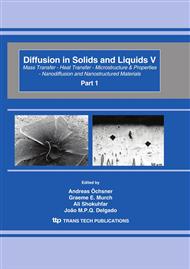p.233
p.239
p.244
p.254
p.263
p.269
p.275
p.281
p.294
Metallographic and Numerical Studies of the Role of Catalyst Particles of MgH2-Mg System
Abstract:
Magnesium is one of the most promising materials for hydrogen storage due to its high capacity and low cost. Unfortunately, practical applications are for the moment limited by the slow kinetics and the high operating temperature. Nanostructuring magnesium hydride MgH2, generally by ball milling, introduces plastic deformations and catalysts that highly enhances the H2 absorption and desorption. However a fundamental understanding of the role played by catalysts and interfaces in MgH2 is still lacking. Microscopic characterization of MgH2-Mg system with and without heavy metal catalysts, is achieved by combining accurate SEM observations of samples after partial desorption process and atomic level ab-initio molecular dynamics simulations of MgH2-Mg interfaces. The experimental method is based on low voltage SEM observations of cross sectional powder samples, prepared by a new specific metallographic process. Identification of nucleation sites of the sorption reaction and their correlation with the presence of catalyst particles is achieved by suitable experimental conditions. Moreover ab-initio molecular dynamics clarifies the interplay of interfaces and the deformations induced during desorption by the presence of catalysts that are able to lower binding energies and free hydrogen atoms toward interfaces. Both approaches confirm and characterize the nucleation step in the catalysts driven phase transformation.
Info:
Periodical:
Pages:
263-268
Citation:
Online since:
April 2010
Price:
Сopyright:
© 2010 Trans Tech Publications Ltd. All Rights Reserved
Share:
Citation:


